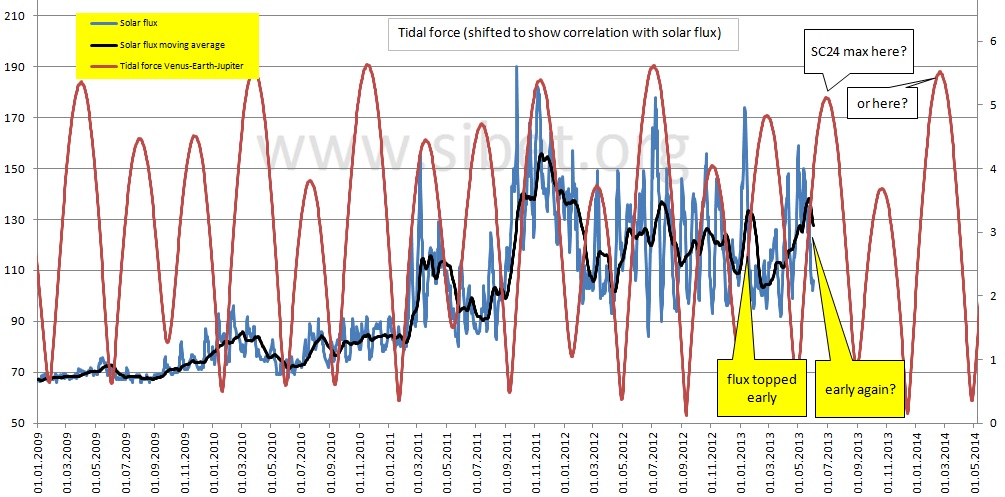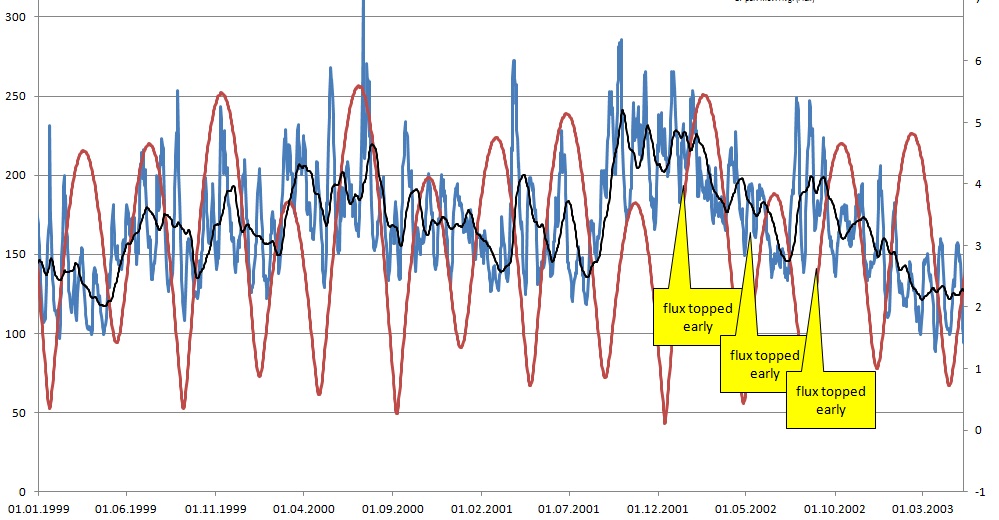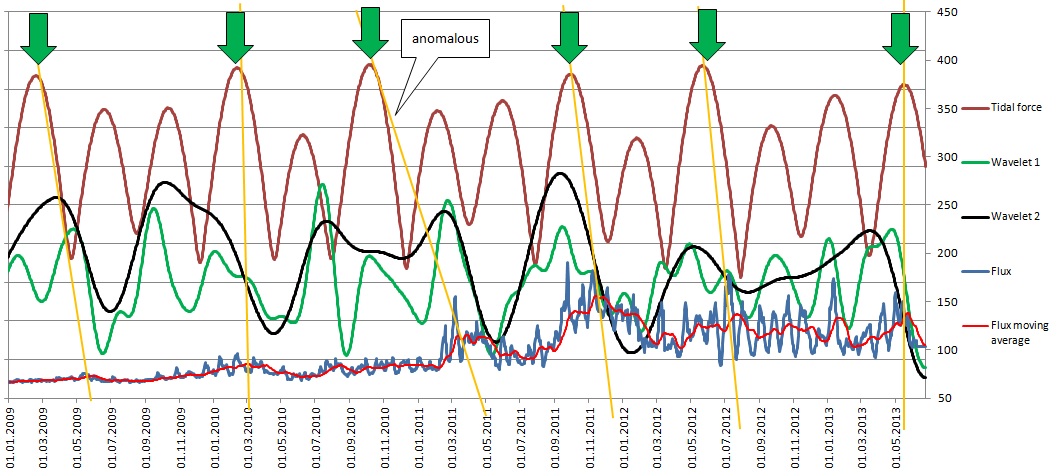bigbud
Level 3 Rank
  
Posts: 180
|
Post by bigbud on Jun 2, 2013 8:49:50 GMT
a look at solar flux versus my ~4 month planetary Venus-Earth-Jupiter tidal force cycle. My work has found a correlation between the tidal force cycle and flux. The average cross correlation shows a lag of ~40 days, but the lag may not be the same through the sunspot cycle. The physical explaination is not known, but I like to see it this way: beneath the surface the sunspots grow (invisible). And when they are hit by the periodic 4 month tidal wave, they are uncovered, stirred up, mature, “explode” and fade away. But throuh the sunspot cycle, the speed of this mechanism may change (and I do think it does, allthough I havent analyzed it yet) Here is SC24. It may suggest that the lag is changing, getting shorter. The red tidal cycle is shifted about 40 days to fit the flux-tops. However the two recent flux-tops seem to come earlier, and top about the same time as the tidal cycle. Could mean that there are less spots to uncover, or that they mature faster. Have to wait and see the next month whether flux stays weak, or ramps up again.  Here is the previous sunspotcycle 23. This is of course a simplyfied model, and I dont expect the correlation to be perfect all the time (the Sun is a messy place). I do however think there is a nice correlation here as expected. Visually there seems to be a change in lag from around year 2002, where the fluxtops come early… just like now? Could be that there is a pattern of shorter lag as the sunspotcycle tops out…  |
|
|
|
Post by sigurdur on Jun 2, 2013 14:49:13 GMT
Thank you. The idea is very interesting.
|
|
bigbud
Level 3 Rank
  
Posts: 180
|
Post by bigbud on Jun 9, 2013 21:20:25 GMT
update on sunspotcycle Two mechanisms: First he “dynamo”, angular momentum, wobble etc has a cycle that is topping around September 2013. This cycle tells what kind of “potential” that lies beneath the Suns surface www.sibet.org/solar/sc24_forecast_jusa.jpgSecond the tidal cycle shows what goes on on the shorter term. This mechanism “pulls up” the sunspots from below the surface, and/or exhaust those that allready are floating. Messy image:  Two observations: 1-the tidal cycle (dark red) corresponds with local flux tops (green wavelet). Mostly the flux-tops lags the tidal tops. 2-every two or three tidal tops are major, producing major peaks in solar flux (black wavelet). One peak was lagging more than normal, and cannot be explained by this simplyfied model. Current situation: May 16 was a major tidal peak, and has so far produced a major flux top also in May. Now flux has dropped much, and it looks like the major top is done (unless there is a lagging peak still ahead). The next major tide is in January 2014, where the dynamo has turned down. After this tide, the tidal cycle is also loosing strength. Conclusion: At the moment it looks like we have had the major flux-top after the May 16 tidal top. And the next major tide in January should be too late to produce a solar maximum. So unless there is an anomalous flux-top coming next months… it looks like this sunspot cycle is about to roll over. But we know for certain first around March 2014. If flux stays weak this fall, it is a pretty good indication that we have started to roll over. |
|
|
|
Post by karlox on Mar 11, 2014 9:43:27 GMT
"In summary, evidence from an array of simple tests does not support belief in a reliable relationship between sunspot activity and stock market returns"
This sounds reasonable
|
|
|
|
Post by icefisher on Mar 12, 2014 5:03:04 GMT
"In summary, evidence from an array of simple tests does not support belief in a reliable relationship between sunspot activity and stock market returns" This sounds reasonable I recall there was a relationship between wheat prices and solar activity. If so, then maybe we can conclude we have adapted fairly well to normal climate change. |
|
|
|
Post by justsomeguy on Mar 20, 2014 16:31:44 GMT
Everyone predicts the sunspot low will occur during that period, and most predict solar cycle 25 will be very low based on the solar dynamo. Does your method predict anything that is abnormal or disagrees with "normal" solar science? That will be the thing to give your theory some credence.
|
|